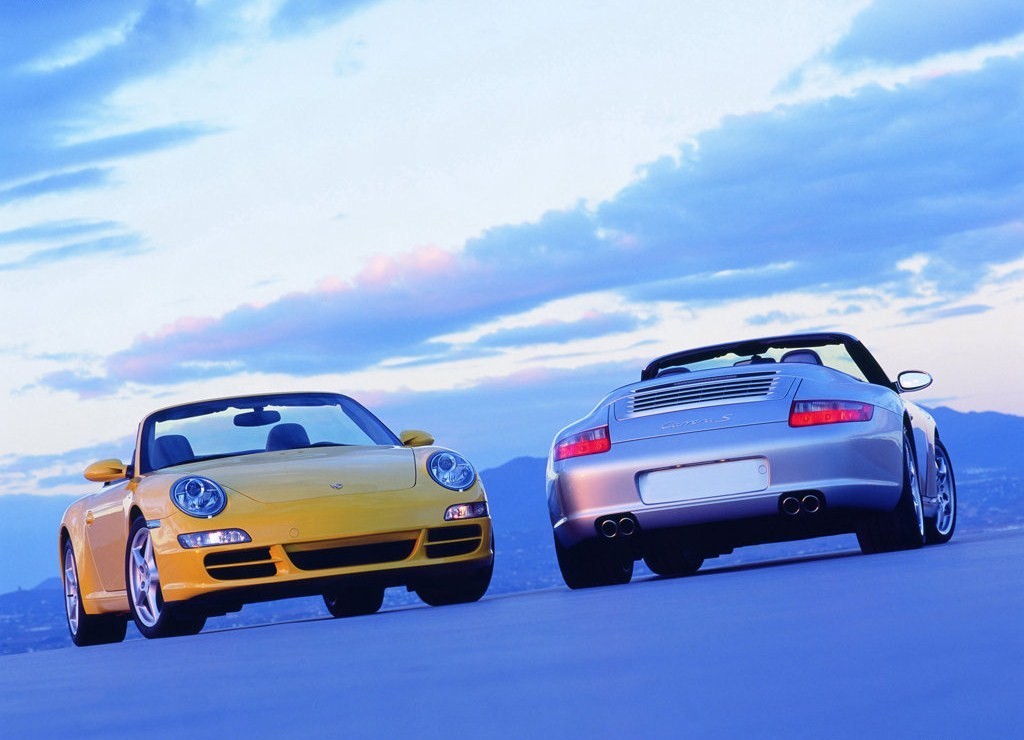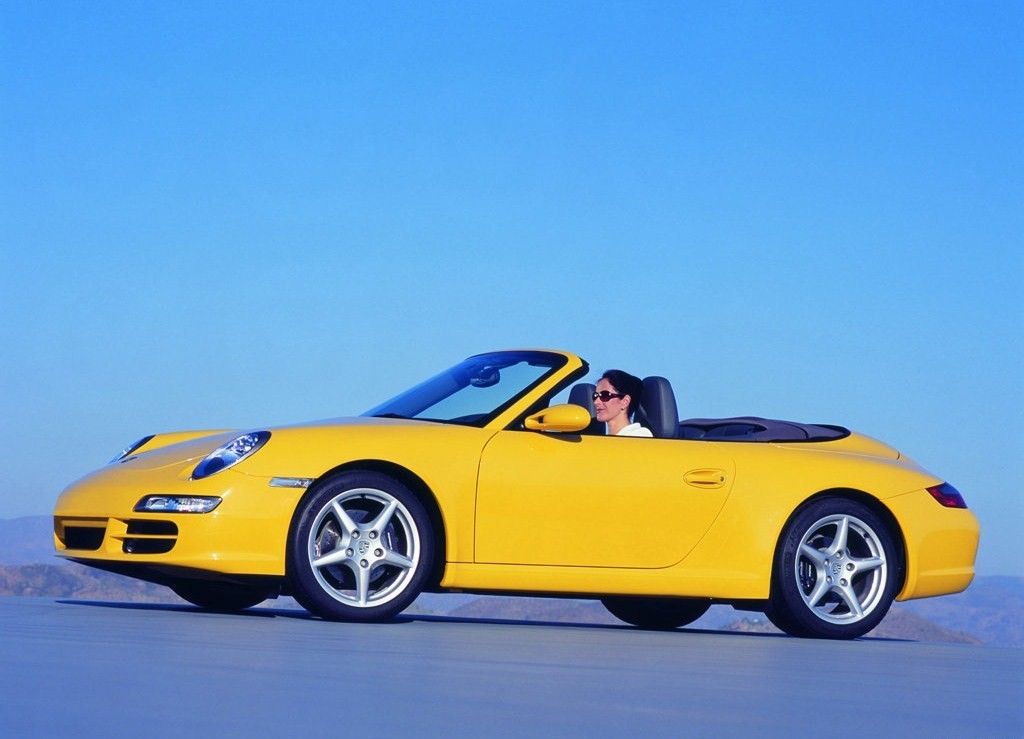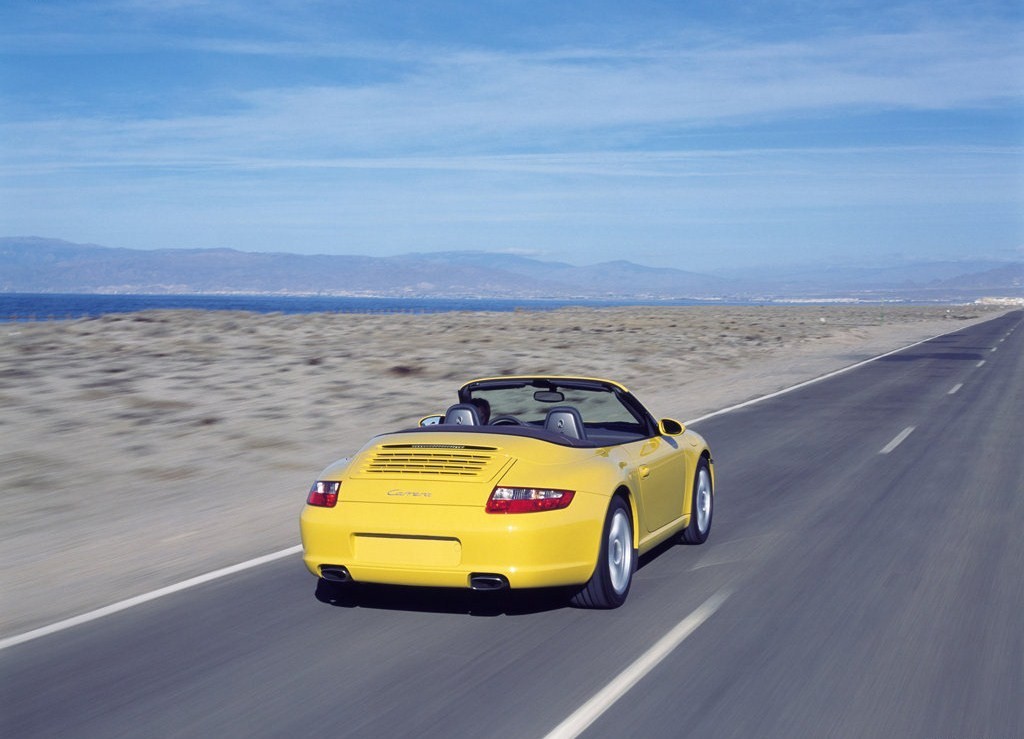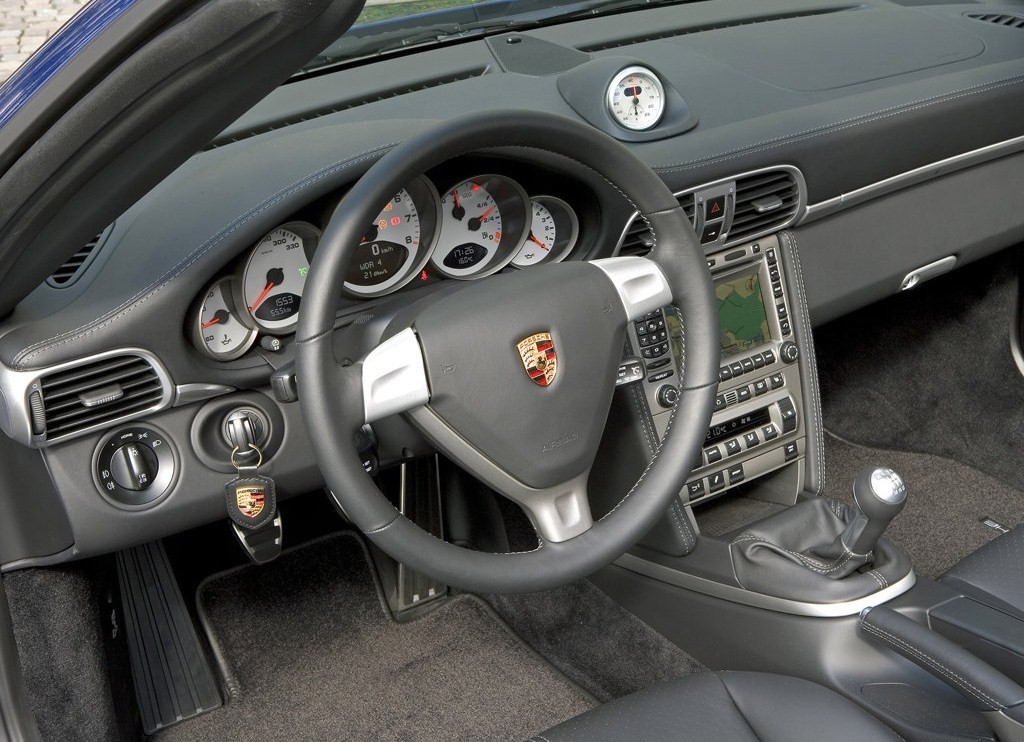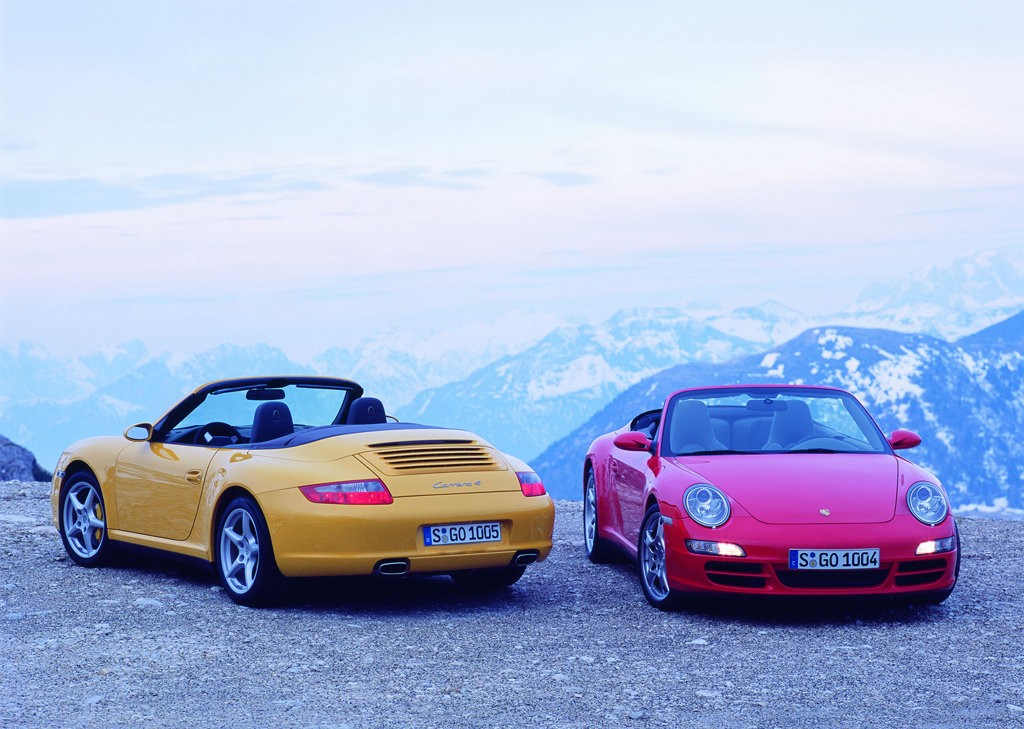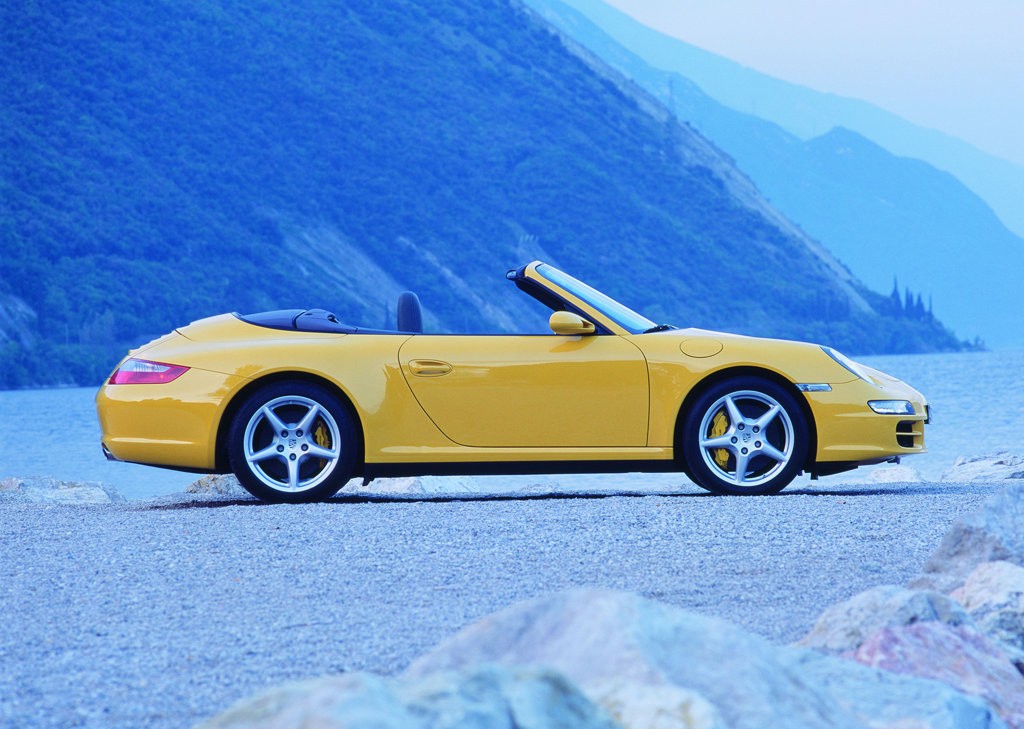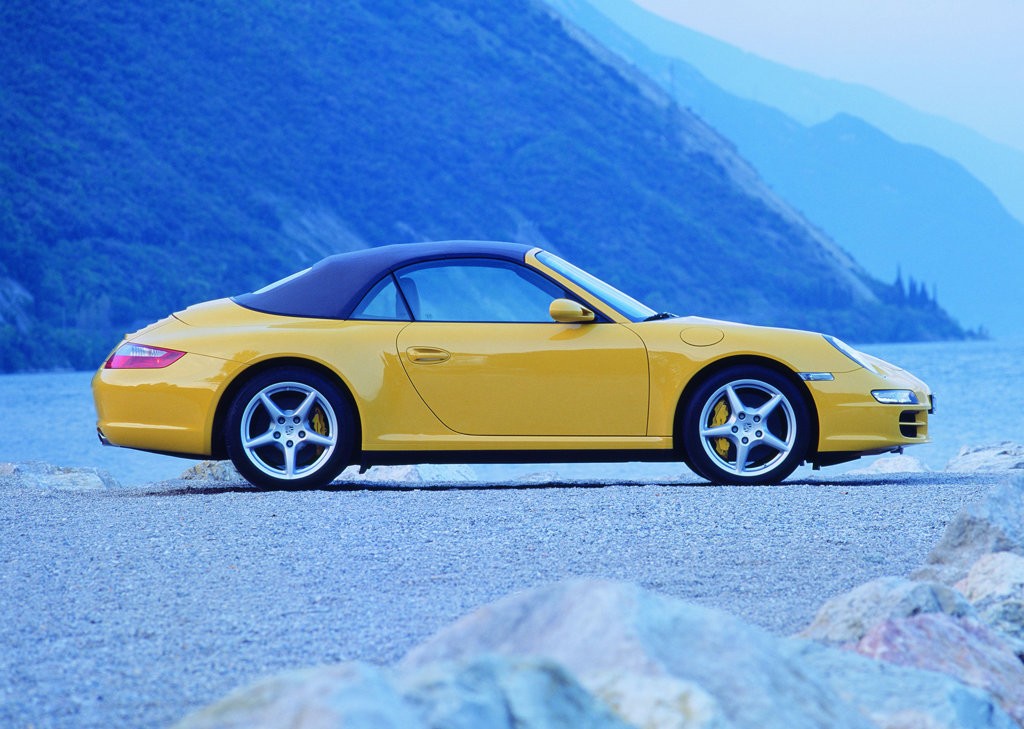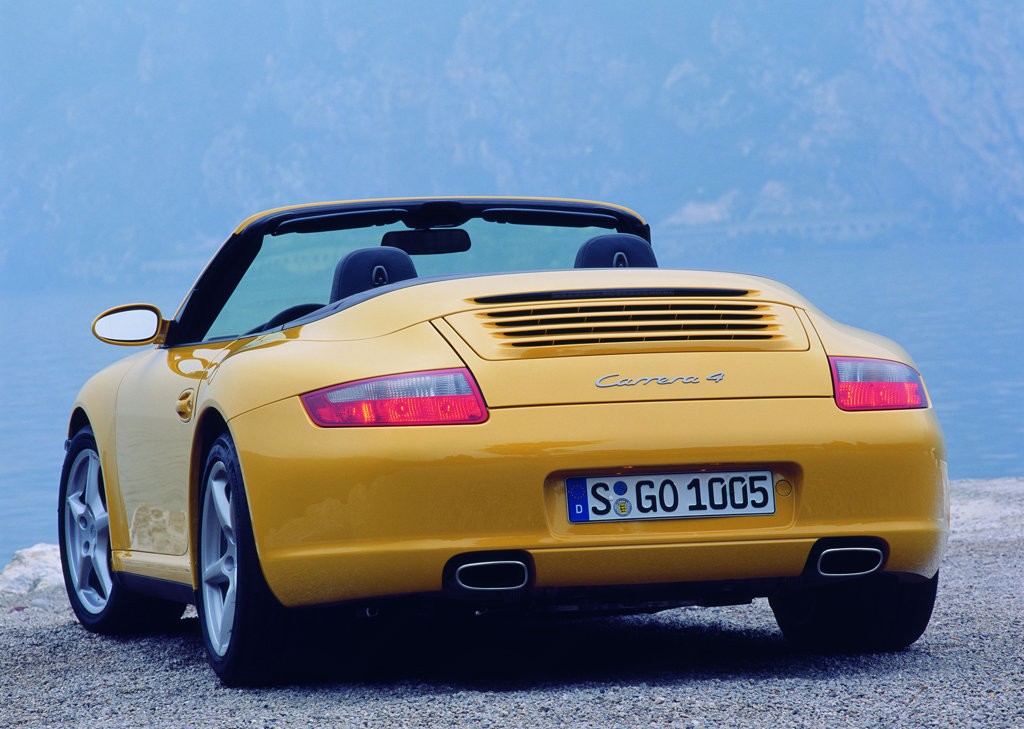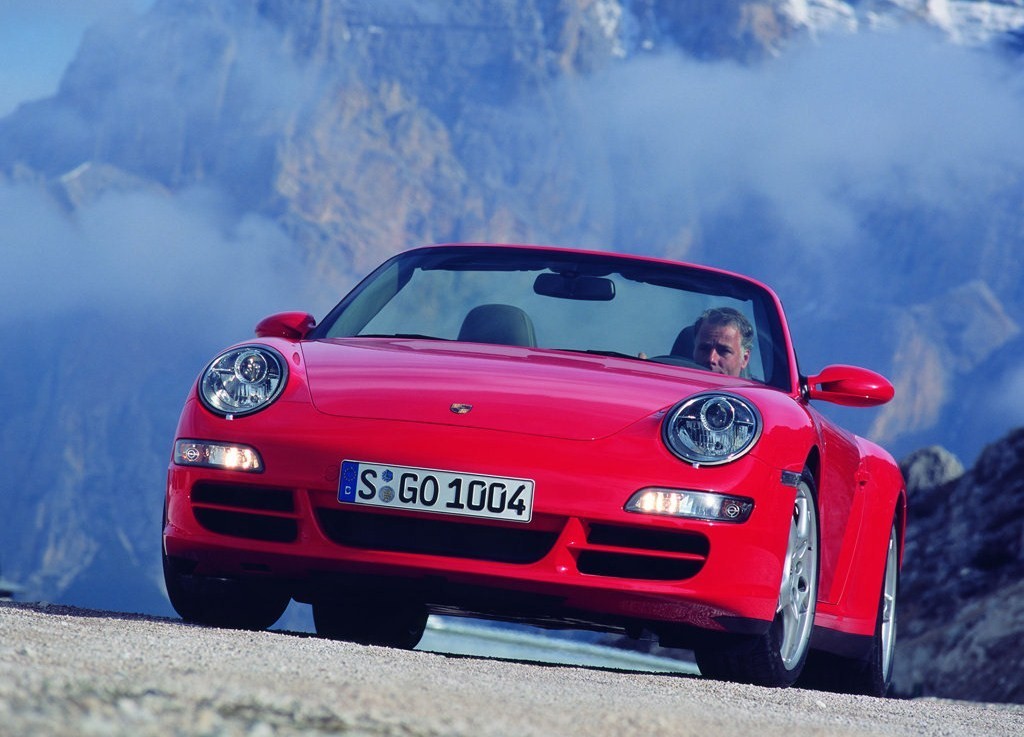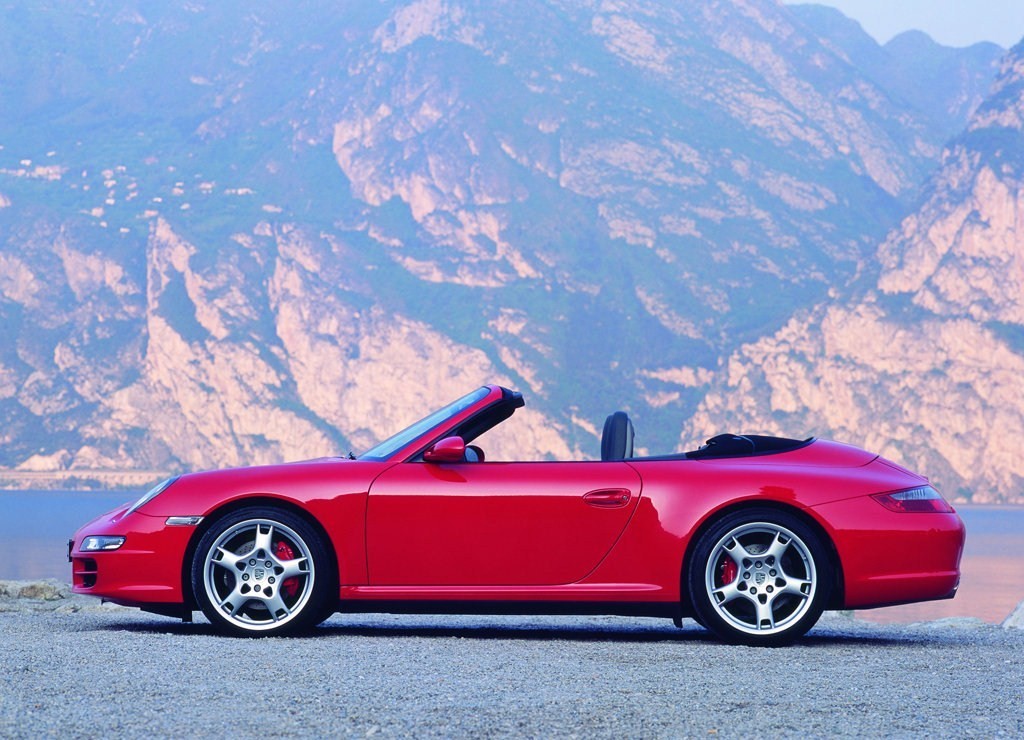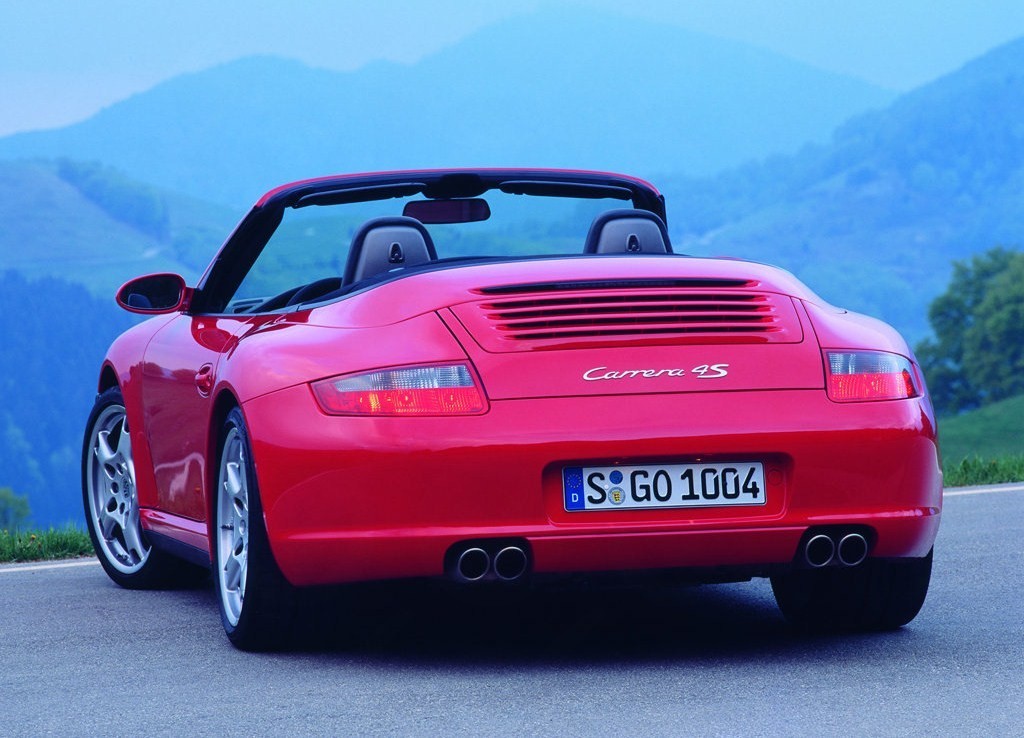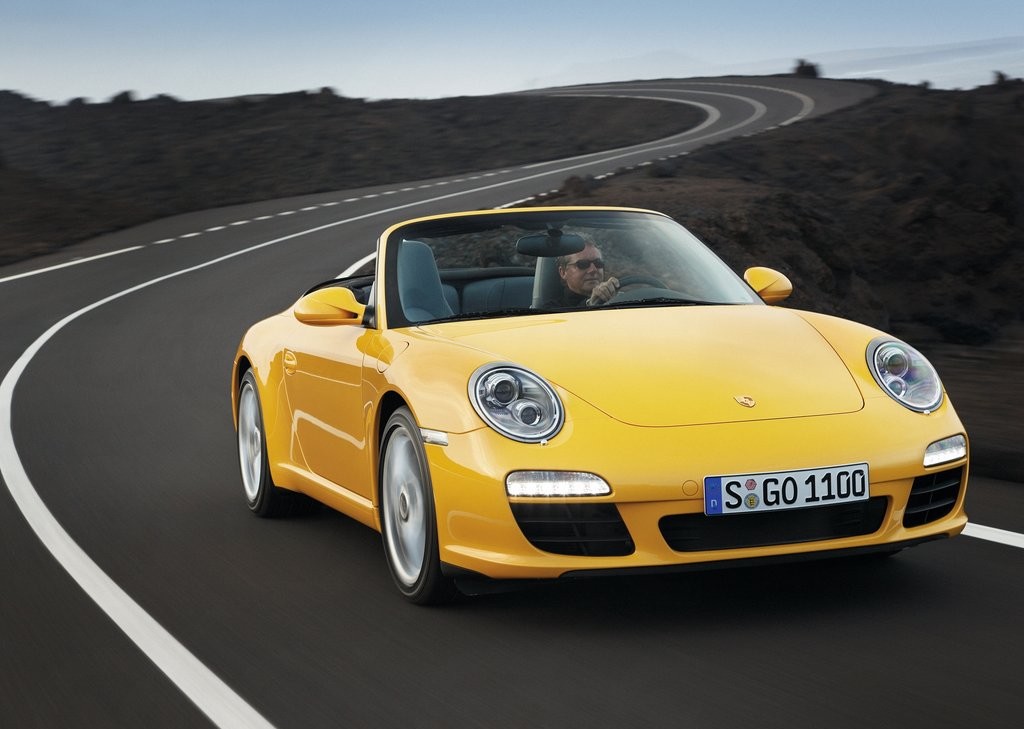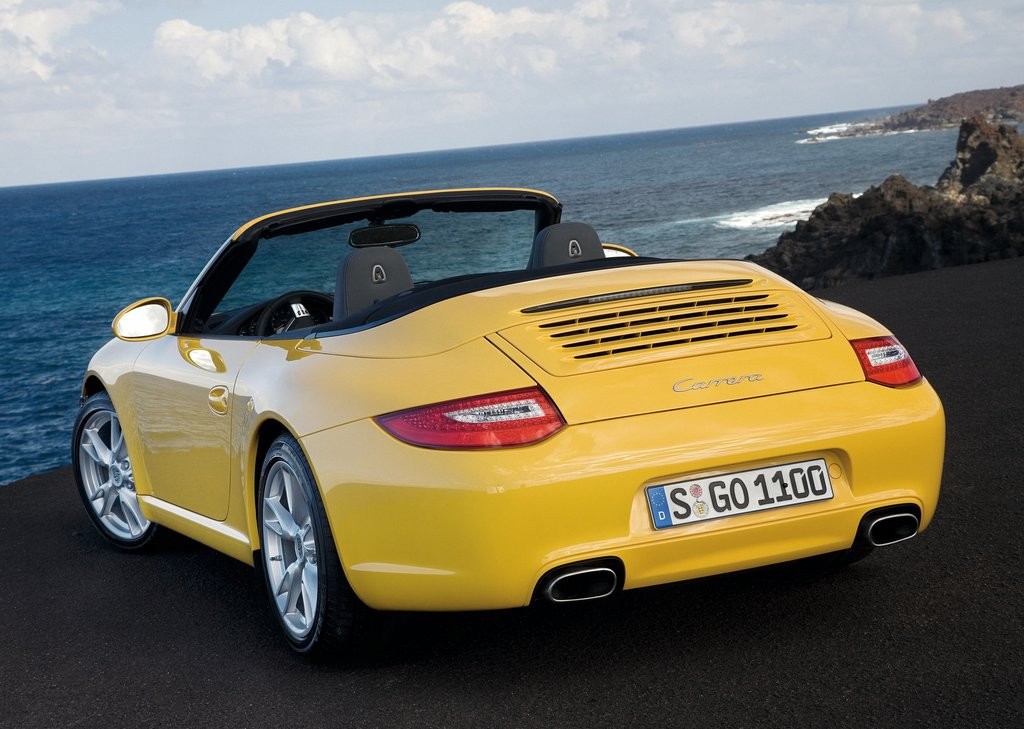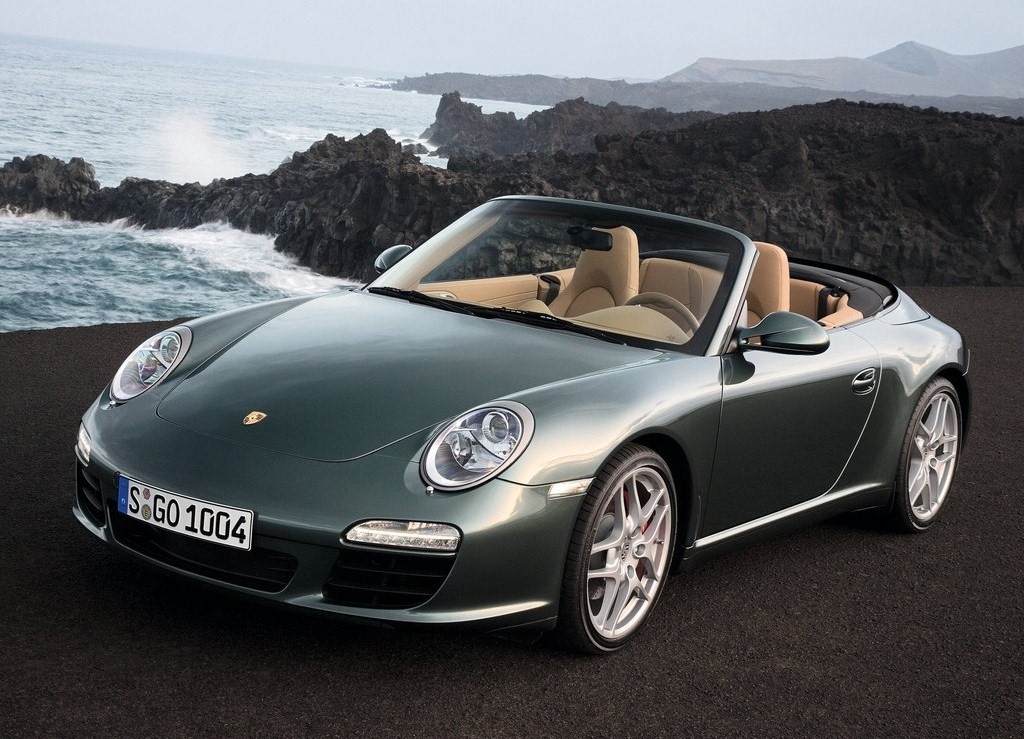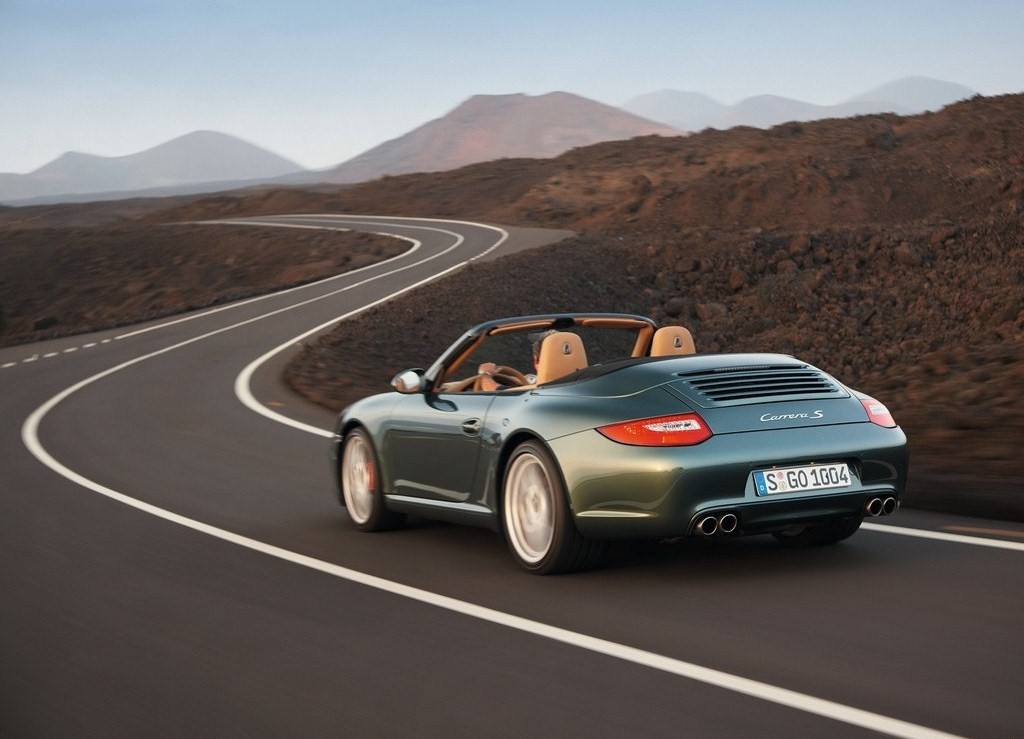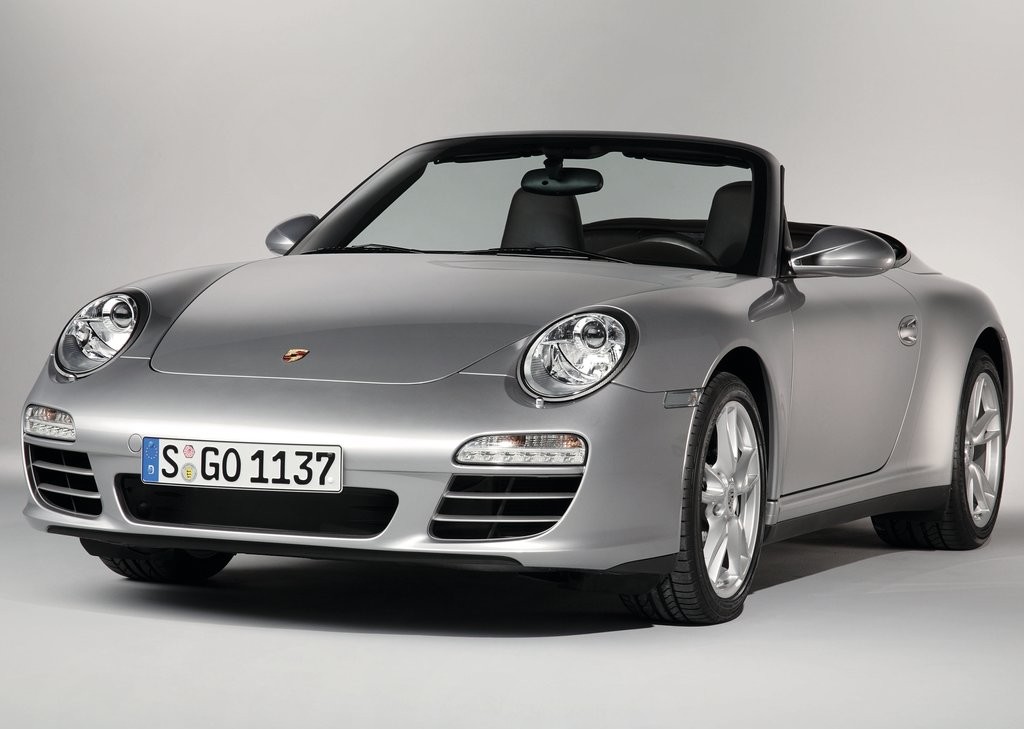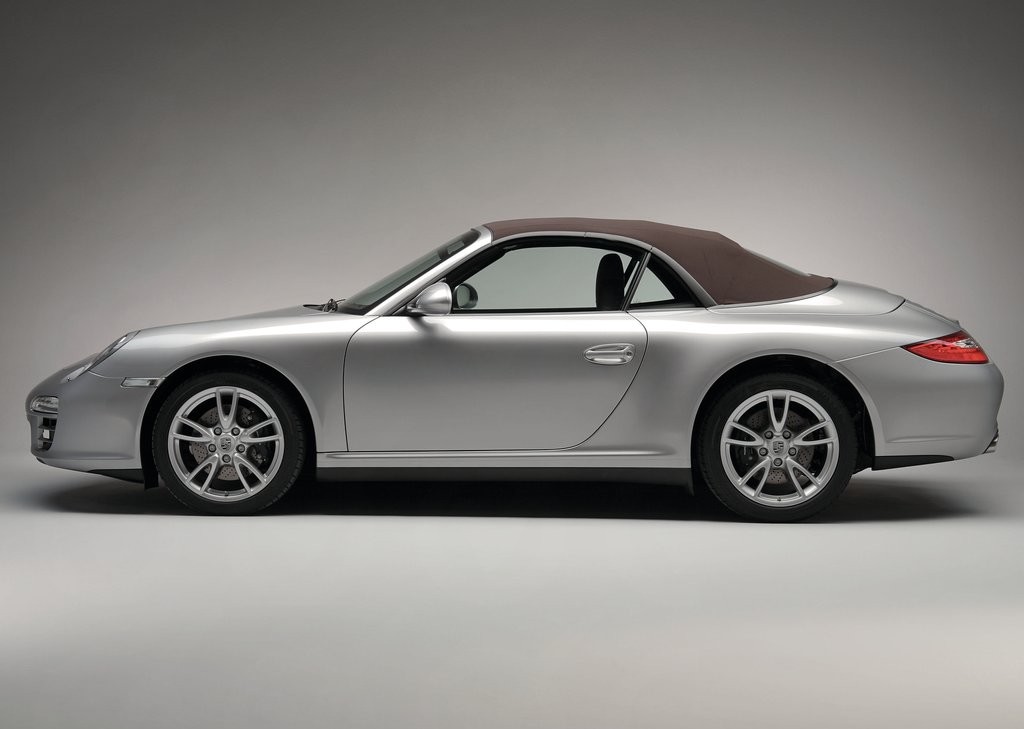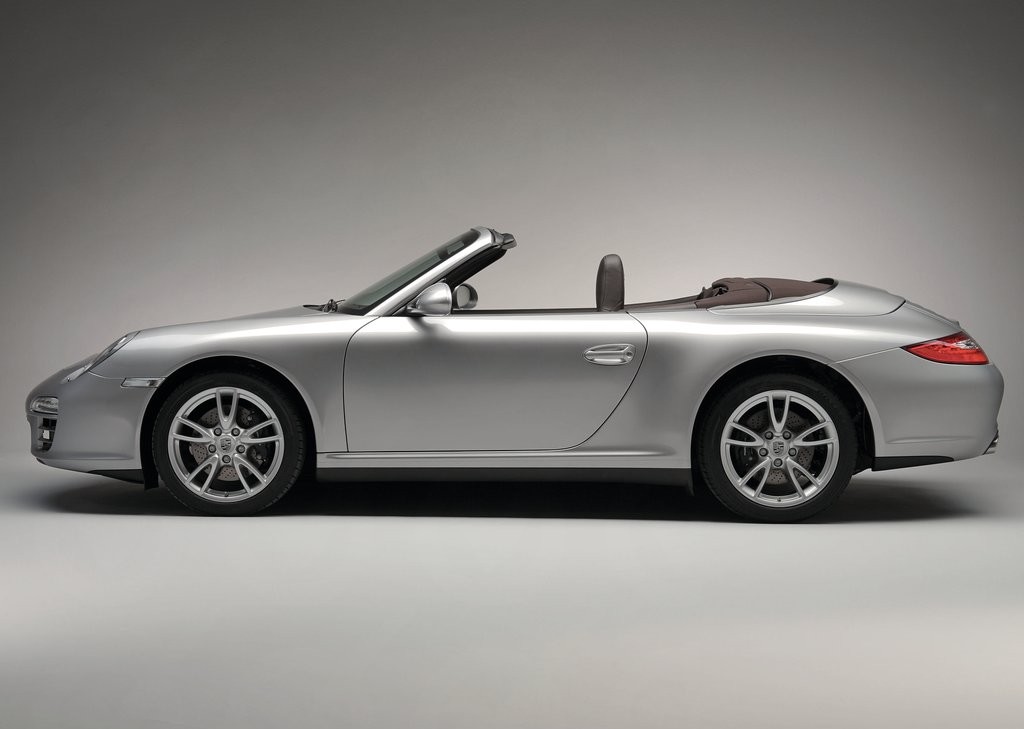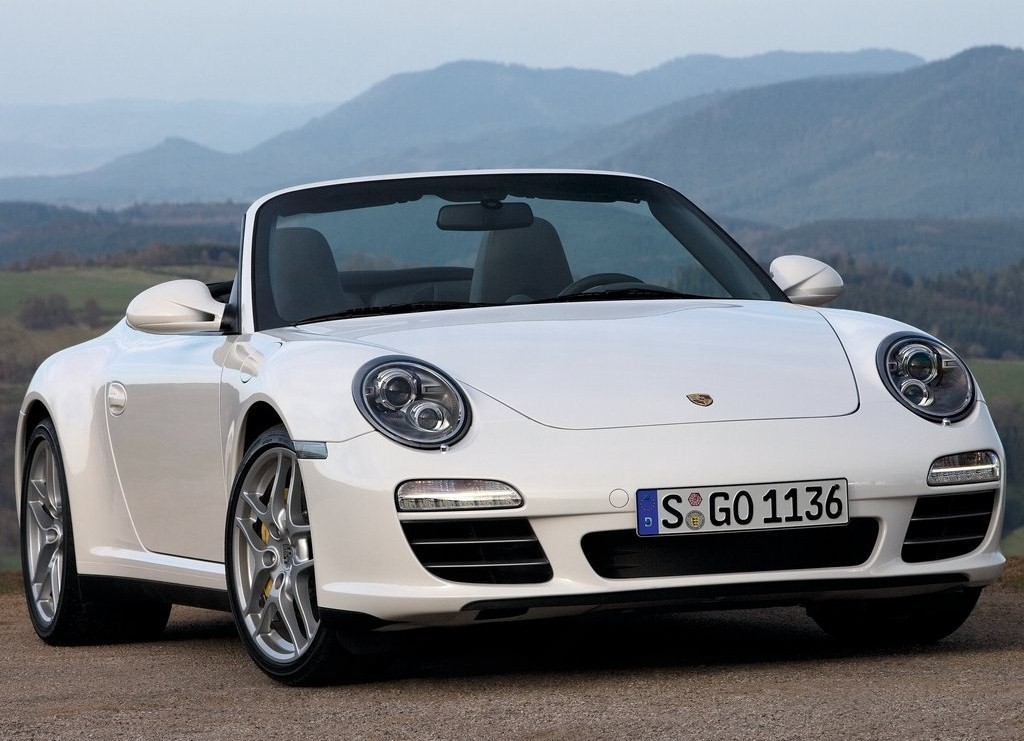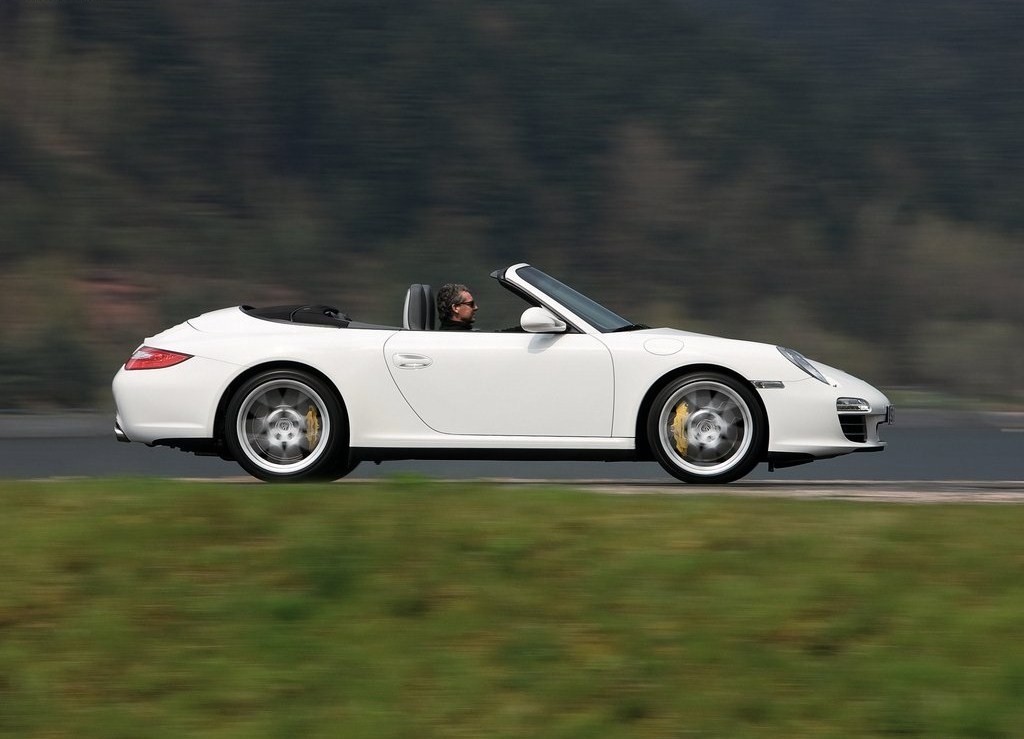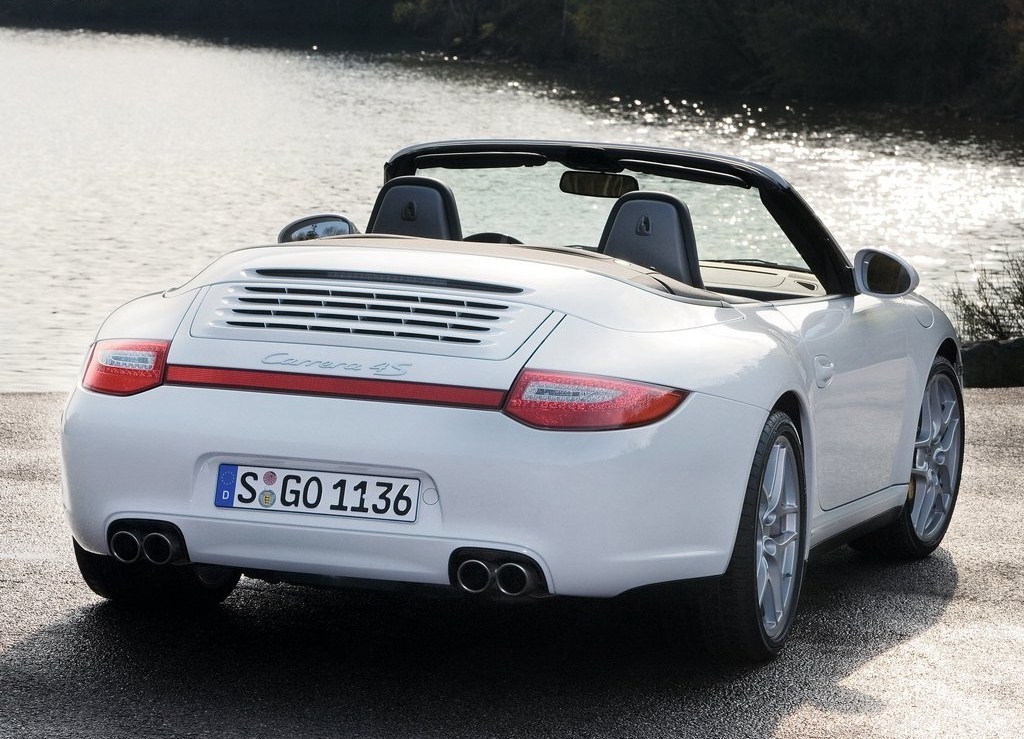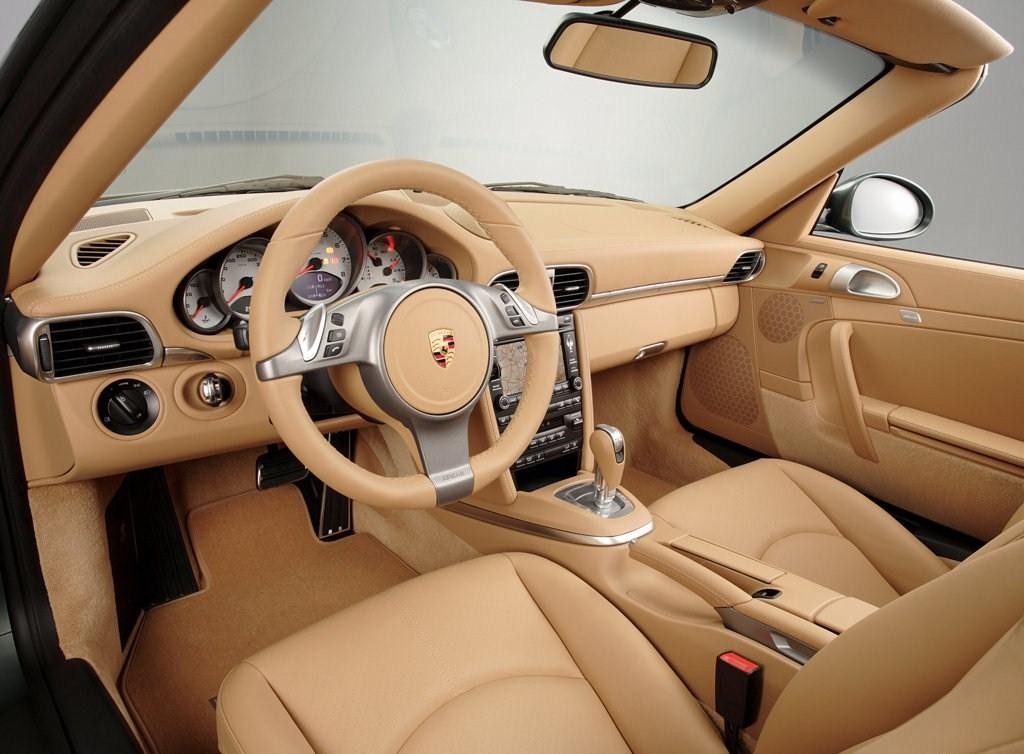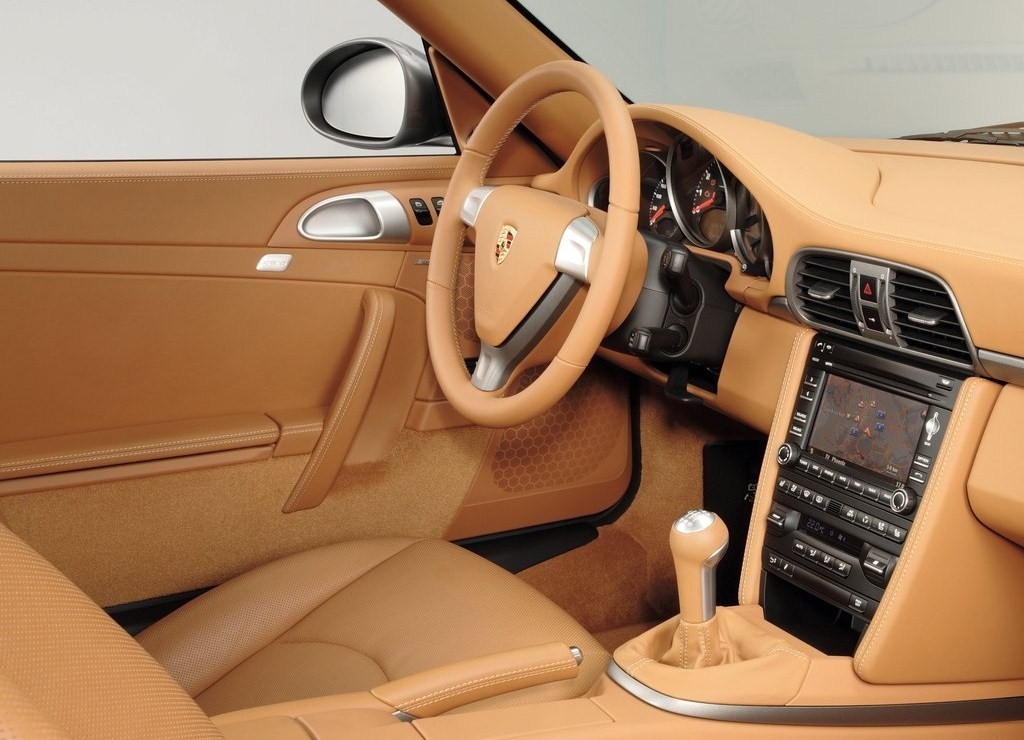
- Free-revving flat six-cylinder engines
- Refined, precise and quick-shifting manual transmission
- Supportive front seats
- Soft-top roof is well-insulated and quick to open/close
- Excellent ride/handling balance
- Variable ratio steering is accurate…
- … but lacks weight in initial movement off-centre
- Tiptronic transmission blunts performance
- Steering rack rattle and scuttle shake over bumpy roads
- Impractical rear seats
Review: Porsche 997.I 911 Cabriolet (2005-08)
Overview
Released in April 2005, the Porsche 997 Series I (997.I) 911 Cabriolet was a two-door cabriolet with a soft-top roof. Manufactured in Stuttgart, Germany, the 997 911 Cabriolet range initially consisted of rear-wheel drive Carrera variants, with all-wheel drive Carrera 4 variants following in August 2005. The range was further expanded with Turbo variants in September 2007; the full range is given in the table below.
Engines
The 3.6- and 3.8-litre horizontally-opposed, six-cylinder engines featured liquid-cooling, dry-sump lubrication, double overhead camshafts, four valves per cylinder and Porsche’s VarioCam Plus intake valve timing and lift system. The Turbo variants were fitted with 3.6-litre engines which featured parallel, variable geometry turbochargers.
Dimensions and suspension
Compared to the 996 911 Cabriolet , the 997 911 Cabriolet was 3 mm shorter (at 4427 mm), 43 mm wider (1808 mm) and 5 mm taller (1310 mm), though wheelbase length was unchanged (2350 mm). The 997 911 Cabriolet was fitted with MacPherson strut front suspension and multi-link rear suspension, and also introduced variable ratio steering.
| Variant | Year | Drive | Engine | Trans. | Peak power | Peak torque |
|---|---|---|---|---|---|---|
| Carrera | 2005-08 | RWD | 3.6-litre M96.05 petrol F6 | 6sp man., 5sp auto |
239 kW at 6800 rpm | 370 Nm at 4250 rpm |
| Carrera S | 2005-08 | RWD | 3.8-litre M97.01 petrol F6 | 6sp man., 5sp auto |
261 kW at 6600 rpm | 400 Nm at 4600 rpm |
| Carrera 4 | 2005-08 | AWD | 3.6-litre M96.05 petrol F6 | 6sp man., 5sp auto |
239 kW at 6800 rpm | 370 Nm at 4250 rpm |
| Carrera 4 S | 2005-08 | AWD | 3.8-litre M97.01 petrol F6 | 6sp man., 5sp auto |
261 kW at 6600 rpm | 400 Nm at 4600 rpm |
| Turbo | 2007-08 | AWD | 3.6-litre M97.70 twin-turbo petrol F6 | 6sp man., 5sp auto |
355 kW at 6000 rpm | 620 Nm at 1950-5000 rpm |
AWD system
The Carrera 4 models were fitted with an all-wheel drive system which utilised a viscous multiple-plate clutch to send power to a central driveshaft which connected to the front differential to deliver between 5 and 40 per cent of the engine’s torque to the front axle.
The 911 Turbo, however, was fitted with an electronically controlled multi-plate clutch which could instantaneously transfer between 80 to 100 per cent of the engine’s torque from the rear axle to the front. On a dry road and under constant throttle, 60 per cent of the engine’s torque was directed to the rear axle. However, the system continuously monitored driving conditions (i.e. wheel rotation speeds, steeringle angle, longitudinal and lateral acceleration) and could send additional torque to the front axle to prevent lateral instability.
Safety equipment
Standard safety equipment for the 997 911 Cabriolet included dual front airbags, front seat-mounted side airbags, front door-mounted head airbags, ABS, electronic stability control, traction control, automatically deploying rollover bars and front seatbelts with pretensioners and load limiters.
The all-wheel drive models were also fitted with two additional braking functions:
- ‘Brake Pre-Filling’, which closed the air gap between the brake pads and discs when sudden accelerator pedal lift-off was detected (improving initial brake performance); and,
- ‘Brake Assistant’, which detected when brake pedal pressure was applied quickly, but not with full force, and increased braking assistance.
Brakes
The Carrera and Carrera 4 had cross-drilled and ventilated 318 mm by 28 mm front brake discs and 299 mm by 24 mm rear discs, both fitted with four-piston black monobloc Brembo calipers. The Carrera S and Carrera 4 S, however, had 330 mm by 34 mm front brake discs and 299 mm by 28 mm rear discs, both fitted with larger, reinforced red calipers. Finally, Turbo variants had 350 mm ventilated front discs with six-piston front calipers and 350 mm rear discs.
Features
Standard features for the 911 Carrera and Carrera 4 included 18-inch alloy wheels, a nine speaker Bose sound system with a six-disc CD player and MP3-compatibility, climate control air conditioning, satellite navigation, leather seats, twelve-way power adjustable front seats, cruise control, front fog lights, a leather-wrapped steering wheel, split and folding rear seats, a leather-wrapped steering wheel, remote central locking, power windows and heated mirrors, a height and reach adjustable steering wheel, driver memory settings (front seat and door mirrors), alcantara roof-lining, a trip computer, motion-sensing alarm and an immobiliser.
The 911 Carrera S and Carrera 4 S were further equipped with 19-inch alloy wheels with 10mm lower sports suspension, bi-xenon headlights with washers, metallic interior highlights and Porsche Active Suspension Management (PASM), which provided selectable ‘normal’ and ‘sport’ modes for the adjustable dampers.
The 911 Turbo was similarly equipped to the Carrera S and Carrera 4 S, albeit with a single CD player and upgraded brakes (see above). The Turbo variants were also fitted with aluminium bonnets and door panels to reduce mass.
Review: Porsche 997.II 911 Cabriolet (2008-12)
Overview
Released in October 2008, the 997 Series II (997.II) 911 Cabriolet introduced direct-injection engines for the Carrera, Carrera 4 and Turbo variants, a seven-speed double-clutch transmission (Porsche’s PDK or Porsche-Doppelkupplungsgetriebe) and cosmetic updates. The direct-injection engines were more powerful, lighter, had greater structural rigidity and 40 per cent fewer moving parts due to new timing chain technology and one-piece cylinder heads. The suspension also featured revised spring, damper and anti-roll bar settings, including an additional stop spring on the front and rear axles.
Visually, the 997.II 911 Cabriolet could be identified by its new front and rear bumpers, larger front air intakes, new front light units above the air intakes, daytime LED running lights and LED brake lights; the Carrera 4 variants also had a full-length rear reflector between the tail-lights and silver-coloured front air-dam strakes. Inside, there was a third-generation Porsche Communications Management (PCM) system, featuring a bigger 6.5-inch touch-screen.
Other changes included:
- An upgraded braking package for the Carrera and Carrera 4 which consisted of 330 mm by 34 mm front brake discs and 330 mm by 28 mm rear discs; and,
- For the Carrera S and Carrera 4 S, an upgraded PASM system which provided a firmer ride.
| Variant | Year | Drive | Engine | Trans. | Peak power | Peak torque |
|---|---|---|---|---|---|---|
| Carrera | 2008-12 | RWD | 3.6-litre MA102 petrol F6 | 6sp man., 7sp DCT |
254 kW at 6500 rpm | 390 Nm at 4400 rpm |
| Carrera S | 2008-12 | RWD | 3.8-litre MA101 petrol F6 | 6sp man., 7sp DCT |
283 kW at 6500 rpm | 420 Nm at 4400 rpm |
| Carrera GTS | 2011 | RWD | 3.8-litre MA101S petrol F6 | 6sp man., 7sp DCT |
300 kW at 7300 rpm | 420 Nm at 4200-5600 rpm |
| Carrera 4 | 2008-12 | AWD | 3.6-litre MA102 petrol F6 | 6sp man., 7sp DCT |
254 kW at 6500 rpm | 390 Nm at 4400 rpm |
| Carrera 4 S | 2008-12 | AWD | 3.8-litre MA101 petrol F6 | 6sp man., 7sp DCT |
283 kW at 6500 rpm | 420 Nm at 4400 rpm |
| Speedster | 2011 | RWD | 3.8-litre MA101S petrol F6 | 7sp DCT | 300 kW at 7300 rpm | 420 Nm at 4200-5600 rpm |
| Turbo | 2009-12 | AWD | 3.8-litre MA170 twin-turbo petrol F6 | 6sp man., 7sp DCT |
368 kW at 6000 rpm | 650 Nm at 1950-5000 rpm |
| Turbo S | 2010-12 | AWD | 3.8-litre MA170 twin-turbo petrol F6 | 7sp DCT | 390 kW at 6250-6750 rpm | 700 Nm at 2100-4250 rpm |
AWD system
As per the 997.I 911 Turbo, the Carrera 4 and Carrera 4S were fitted with an electronically controlled multi-plate clutch. Unlike their predecessors’ viscous multi-plate clutch, this system enabled an infinitely variable front/rear torque split, though two-thirds of the engine’s torque was directed to the rear wheels in normal conditions. The Carrera 4 models were also fitted with a limited slip rear differential which had a 22 per cent locking action under power and 27 per cent locking action in over-run.
Safety equipment
Standard safety equipment for the 997.II 911 Cabriolet was also improved as the rear-wheel drive models were fitted with the ‘Brake Pre-Filling’ and ‘Brake Assistant’ functions (previously limited to all wheel drive models).
Features
Standard features for the 997.II 911 Cabriolet were extended to include auxiliary USB/iPod inputs, bi-xenon headlights with washers, Bluetooth connectivity and rear parking sensors.
Porsche 911 Cabriolet Turbo S
Released in August 2010, the Turbo S was fitted with 19-inch central-locking alloy wheels, directional headlights and features that were optional on the standard Turbo variant, including:
- Porsche Torque Vectoring (PTV), which consisted of braking the inner rear wheel when cornering to reduce understeer;
- The Sport Chrono package, including Launch Control and Porsche Active Drivetrain Mounts (dynamic engine mounts which utilised a magnetorheological fluid and an electric current to vary the damping stiffness between engine and body); and,
- Porsche Ceramic Composite Brakes (PCCB).
Porsche 911 Carrera GTS
Released in January 2011, the rear-wheel drive Carrera GTS was powered by a more powerful 3.8-litre engine which had a new resonance intake system. Compared to the Carrera S on which it was based, the Carrera GTS had the same 44 mm wider rear-end as the all-wheel drive models, with front and rear track increased by 2 mm and 32 mm, respectively.
Visually, the Carrera GTS could be identified by its 19-inch ‘RS Spyder’ black-painted alloy wheels with 235/35 ZR19 front and 305/35 ZR19 rear tyres, SportDesign front bumper with a black spoiler edge and black side skirts. The Carrera GTS was similarly equipped to the Carrera S, but distinguished by its sports seats with Alcantara and SportDesign steering wheel, gear lever and handbrake; the rear seats were also omitted, though could be optioned at no extra cost.
2011 Porsche 911 Speedster
Released in early 2011, the 911 Speedster was a limited-run model with only 356 vehicles produced worldwide. Fitted with a more powerful 3.8-litre engine as per the Carrera GTS, the rear-wheel drive Speedster was solely available with the seven-speed PDK transmission. To reduce weight, the Speedster had a manually-operated convertible roof, aluminium doors, no rear seats and the ceramic brake system (PCCB) was fitted as standard. As a result, the Speedster had the same weight as the Carrera S at 1540 kg.
Visually, the Speedster could be identified by its 60 mm shorter windscreen, 19-inch ‘Sport Classic’ alloy wheels, special front apron, darkened front lamps, black headlight surrounds, unique side skirts, rear apron and unique double bubble on the convertible roof housing. Compared to the Carrera S, track was increased by 6 mm at the front axle and 34 mm at the rear axle (the latter with a reinforced anti-roll bar). The Speedster was also fitted with a rear axle differential lock which provided a 22 per cent locking value on acceleration and 27 per cent on deceleration.
The Speedster was similarly equipped to the Turbo S, but distinguished by its embroidered leather seats and all leather-covered options available within the Porsche Exclusive range.
Brochures
- Brochure: Porsche 997.II 911 Coupe Turbo and 911 Cabriolet Turbo (May 2009)
- Brochure: Porsche 997.II 911 Coupe, Cabriolet and Targa (March 2010)
Related links
